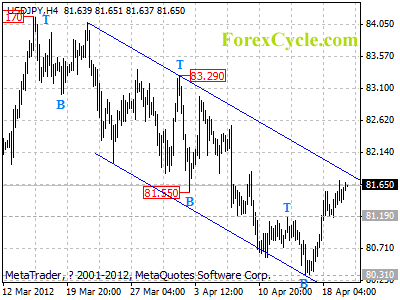Article by Investment U

The smart way to invest in Japan is to take the yen/dollar out of the equation. And the WisdomTree Japan Hedged Equity ETF (NYSE: DXJ) does just that.
About a decade after Japan’s bubble burst, I was having a cool San Miguel beer with a leading money manager at the Hong Kong Jockey Club.
We were discussing the rise of China and whether Japan could snap out of its slump, when my friend made a comment that stuck with me over the years.
“Carl, there’s only room for one big dog in Asia.”
It certainly seems so.
After dominating Asia for a long time, China fell apart after turning inward in the late nineteenth century and early twentieth century. Meanwhile, Japan was turning from isolation to looking outward and re-igniting its economy. This imbalance in strength led to the tragic Sino-Japanese war.
After World War II, Japan immediately began its amazing export-led industrial recovery while China again faced turmoil, turned inward and cut itself from the world under Mao’s misguided leadership.
The Tables Have Turned
Since at least 1990, China surged at double-digit growth rates while the Japanese economy sputtered along.
For Asia’s investment managers, beating their performance benchmark during this time was a piece of cake – just underweight Japan.
But lately, it appears money is flowing from China to Japan. It’s too early to call this a trend, but if you’re a momentum player you’ll want to follow what the big boys are doing.
In the latest survey of global money managers by Bank of America Merrill Lynch, the percentage who said they were underweight Japan shrank sharply – to just 4% in March from 23% in February.
This led to the Japanese market having its best quarter since 1988. And last month, the Nikkei, which rallied 23% since late November, closed above 10,000 for the first time since last summer.
Bears Make Headlines, Bulls Make Money
The bear case for Japan is well known: high debt, slow growth, aging population, gaping budget deficits and dysfunctional politics. To many investors, it seems like yesterday’s story, while emerging markets look like the future.
But there are two sides to every story, and the case for keeping some Japan exposure in your portfolio is clear and compelling…
Almost exactly one year ago I wrote 13 reasons why Japan still had a bright future ahead.
Well here’s a look back at some of those reasons why ignoring Japan may be a mistake, plus a few new ones:
- Sean Darby, Jefferies Chief Global Equity Strategist, expects companies in the Nikkei Index to have earnings growth of 60% in 2012.
- Roughly 95% of Japan’s $10-trillion sovereign debt is currently held by Japanese investors. This means debt funding isn’t dependent on the whims of foreign lenders.
- The country has current gold and foreign exchange reserves of over $1 trillion.
- Japanese companies and banks are flush with cash. Deposits at banks exceed outstanding loans by $1.8 trillion.
- Japan is probably the only developed economy in the world to pull off trade surpluses with China, Taiwan and South Korea. Trade between Japan and Asia has doubled over the last decade.
- Japan’s creative spirits are alive and kicking. The country still is awarded U.S. patents at a rate double that of the Koreans and Taiwanese together.
- The strong yen is giving Japanese companies the upper hand in grabbing overseas companies at cheap prices.
- Share prices in Japan are just above book value compared with double book value in the United States.
- Peter Tasker of Arcus Research finds that 25% of Japan’s companies trade at less than 10 times earnings compared to just 4% for the S&P 500 Index.
- On a price to sales basis, Japan trades two times cheaper than a basket of the BRIC markets (Brazil, Russia, India and China).
- Japan’s market beats to its own drummer, so having some Japan in your global portfolio is a great diversifier. Over the last 10 years, Japan moved in sync with the S&P 500 only 30% of the time.
- Japan’s government is injecting liquidity into the economy to spur the economy and is proposing a cut in corporate tax rates.
- Finally, keep in mind that Japan is still the world’s third-largest economy – just a hair behind China. A big economy like Japan’s won’t post headline-grabbing double-digit economic growth, but can still deliver sizable profits and cash flow.
How to Play Japan
This is all impressive stuff, but how should you invest in Japan’s potential renaissance?
If you chose the popular iShares MSCI Japan Index Fund (NYSE: EWJ) exchange-traded fund, you’re not very happy, even though it gained approximately 8% so far in 2012.
The key reason for EWJ’s surge through the first 10 weeks of this year was a 7% decline in the value of the yen versus the dollar. This is rocket fuel to this EWJ’s export heavy holdings.
This is also double-edged sword, since a weaker yen also cuts into your dollar-based returns.
The solution? Take the yen/dollar out of the equation.
The WisdomTree Japan Hedged Equity ETF (NYSE: DXJ) does just that, which is why it gained nearly 16% this year. Figuring out an investment opportunity is important, but so is picking the best investment tool to capture it.
China’s cascading troubles may reflect a buy point close to Templeton’s principle of “maximum pessimism.” It could also signal that China’s role as Asia’s big dog is waning.
Good Investing,
Carl Delfeld

Article by Investment U



 Tradervox (Dublin) – The Bank of Canada meeting had resolved to keep the monetary policy as it projected an exit following positive global economy. However, this week’s jobless claims from the US have indicated that the bad performance indicated last week is reflective of a trend in the economy but not a onetime event. Following the release of the US jobless claims data, the loonie fluctuated against the US dollar increasing by 0.7 percent and later declining. Canadian dollar had increased as the BOC Governor indicated that the exiting from the stimulus program was appropriate.
Tradervox (Dublin) – The Bank of Canada meeting had resolved to keep the monetary policy as it projected an exit following positive global economy. However, this week’s jobless claims from the US have indicated that the bad performance indicated last week is reflective of a trend in the economy but not a onetime event. Following the release of the US jobless claims data, the loonie fluctuated against the US dollar increasing by 0.7 percent and later declining. Canadian dollar had increased as the BOC Governor indicated that the exiting from the stimulus program was appropriate. Tradervox (Dublin) – Some concerned about the Bank of Japan’s stand on monetary easing policy had been raised earlier this week after some analysts pointed out that the BOJ is confusing traders on its stance. Today, Masaaki Shirakawa, the BOJ Governor set the record straight by reaffirming his commitment to the monetary easing policy.
Tradervox (Dublin) – Some concerned about the Bank of Japan’s stand on monetary easing policy had been raised earlier this week after some analysts pointed out that the BOJ is confusing traders on its stance. Today, Masaaki Shirakawa, the BOJ Governor set the record straight by reaffirming his commitment to the monetary easing policy.
 Tradervox (Dublin) – There has been very positive reports coming from the UK this week, and the pound has found support to rise to 19-month high against the euro. Minutes from the BOE April meeting showed that Adam Posen has dropped is push for further stimulus supporting the current monetary policy which won 8-1 on the vote.
Tradervox (Dublin) – There has been very positive reports coming from the UK this week, and the pound has found support to rise to 19-month high against the euro. Minutes from the BOE April meeting showed that Adam Posen has dropped is push for further stimulus supporting the current monetary policy which won 8-1 on the vote.
 Tradervox (Dublin) – The Aussie and kiwi have come from a one week low after the Xinhua News Agency reported that reserve requirement ratio may be cut in China. The two south pacific dollars had fallen earlier due to a decrease in raw material prices reported by Standard and Poor’s GSCI Index. The New Zealand dollar dropped to a week low against the US dollar while the Aussie shed 0.3 percent.
Tradervox (Dublin) – The Aussie and kiwi have come from a one week low after the Xinhua News Agency reported that reserve requirement ratio may be cut in China. The two south pacific dollars had fallen earlier due to a decrease in raw material prices reported by Standard and Poor’s GSCI Index. The New Zealand dollar dropped to a week low against the US dollar while the Aussie shed 0.3 percent.